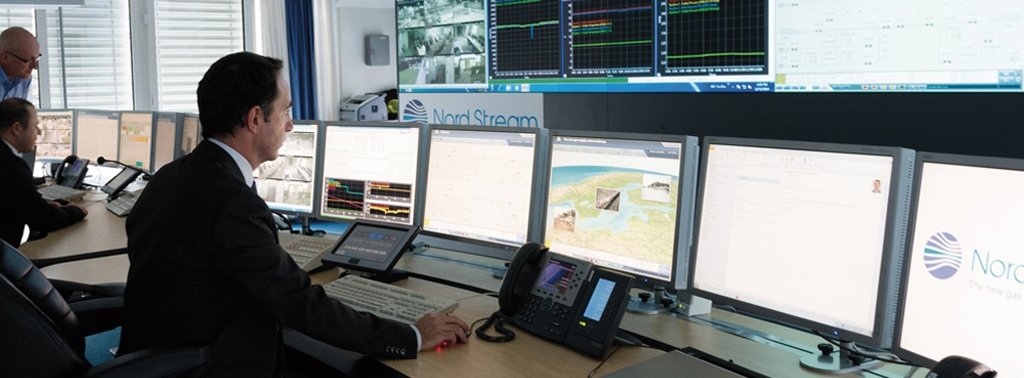Dispatching
Safety is at the very core of operations, and "nominations," or the quantity of gas entering the system at the Russian inlet and the amount extracted downstream in Germany, are at the heart of this. In short, the operators and dispatching staff at Nord Stream's Control Centre must monitor the volume of gas entering the pipelines, the amount extracted, its pressure and temperature, and then calculate if these are all within the safety parameters of the pipelines’ design. To help calculate these safety parameters, sensors throughout the pipelines feed real-time information to the Control Centre. Lights illuminate a video wall display of the pipelines, alerting staff to potential problems. Safety sensors designed to detect hydrocarbons, fire, and smoke are fine-tuned to warn against irregularities.
Safety is maintained through permanent contact with upstream and downstream partners. Nord Stream's role is to permanently monitor the safety conditions and to request both upstream and downstream operators to change the parameters if necessary (for example, flow, pressure, and temperature) to avoid unsafe conditions. It is only in an emergency that Nord Stream would shut things down.
Safe conditions are maintained throughout the nominations process. A nomination is the client’s specification of how much gas they want to flow into the pipelines in Russia and how much they want to offtake in Germany. Nord Stream receives a weekly nomination broken down into days and then a daily nomination, which is broken down into hours. The Gazprom subsidiary Gazprom Export, the world’s largest exporter of natural gas, provides these nominations from its dispatching centre in St. Petersburg, where it controls all Gazprom gas being transported to Europe. It is from this city that Gazprom Export informs Nord Stream how much it wishes to put into the pipelines in Russia and how much it wishes to take out in Germany. The nominations for gas being extracted are based on demand from Gazprom’s partners and customers across Europe, including public utilities, regional gas suppliers, industrial companies, and power plants. Gas transported through the twin pipeline system will move onward through the European grid to Belgium, Denmark, France, the Netherlands, the United Kingdom, and other countries.
Nominations are relayed to the Zug Control Centre from St. Petersburg via a dedicated communication system. Dispatchers in the Control Centre check the nominated values for contractual correctness and check that the values are physically feasible – in other words, that the physical volume can safely flow. On a given day, for example, 164 million cubic metres of gas might enter the pipelines from the Russian inlet while 167.4 million cubic metres are extracted in Germany. It is common for the two figures to be different, for example, that the nomination at the entry point differs from the nomination at the exit point. In this case, the pipelines serve as underwater gas storage, which can be emptied and filled according to the client’s shipping needs, as long as the gas pressure neither falls below nor exceeds critical levels.
Nord Stream's dispatching responsibility is to analyse the nominations, look at the conditions of the system, and then decide whether to allow the nominations or not from a safety point of view. Operating pressure is always regulated according to the pipelines' safety parameters. If more gas is requested for the European grid downstream, flow rates and pressure will be adjusted accordingly.






